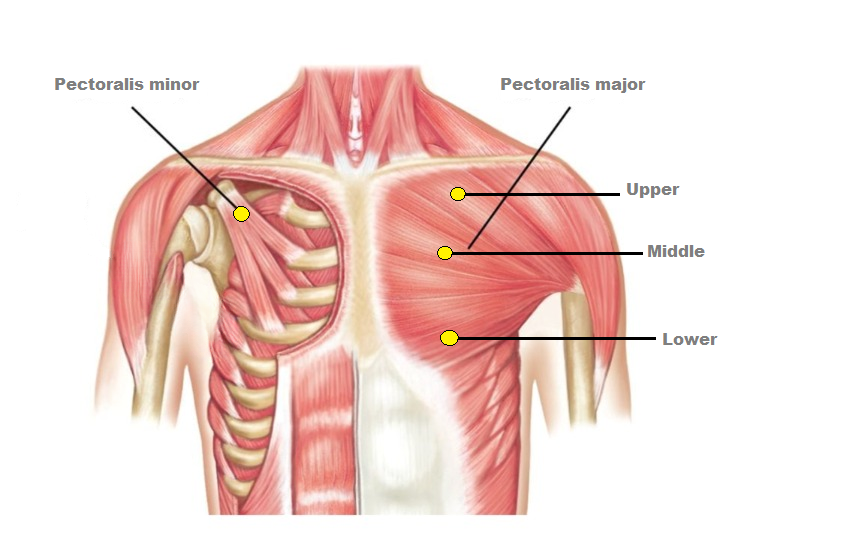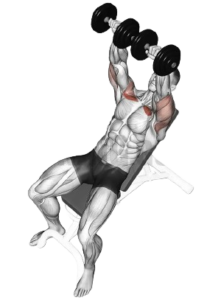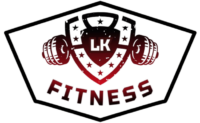Everything You Need To Know About Chest Training
INTRODUCTION

Make Your Torso Fuller By Unlocking Upper Chest: The Best Mass Building Exercises For Upper Chest
Introduction
When it comes to building a well-rounded chest, focusing on the upper chest muscles is key. Not only does a developed upper chest enhance your physique, but it also contributes to overall upper body strength and symmetry. Most beginner-friendly training programs emphasize flat chest press exercises, which, despite contributing to overall chest development, doesn’t necessarily target the upper portion of the chest, therefore, as beginners progress through their fitness journey, the development gap between the middle/lower and upper portions of the chest continues to widen. Consequently, many recreational lifters find themselves with a well-developed lower chest and a ‘lagging upper chest’. Over time, this imbalance becomes more challenging to correct, as the stronger part of the chest tends to dominate while performing an exercise.
Effective Upper Chest Exercises
1. Incline Barbell Bench Press – Essential For Building Upper Chest
How To Do It:
- Adjust the incline bench to a 30-45 degree angle. Ensure it’s securely locked in place.
- Lie on the bench with your back slightly arched against the pad and your feet planted firmly on the floor for stability.
- Grip the bar wider than shoulder-width apart with your wrists straight and aligned with your forearms.
- Lift the barbell off the rack, hold it directly above your chest with your arms fully extended, and start lowering the bar.
- Slowly lower the barbell towards your upper chest in a controlled manner. Keep your elbows slightly tucked to your sides to maintain shoulder safety.
- Exhale and push the barbell back up to the starting position by extending your arms, focus on using your upper chest to perform the movement.
- Perform 3-4 sets of 10-12 repetitions.
2. Incline Smith-Machine Press


Description / How To Do It:
The Incline Smith-Machine Press offers a safer, machine-assisted alternative to the Incline Barbell Bench Press, which provides stability by taking heavy lifting off of your shoulders (Literally), so you can solely focus on muscle contraction. Follow the same steps as you would for the Incline Barbell Bench Press to perform this exercise effectively.
3. Incline Dumbbell Press – Allows For A Greater Range Of Motion And Provides Better Stretch


How To Do It:
- Adjust an incline bench to a 30-45 degree angle. Ensure the bench is stable and securely locked in place.
- Grab a pair of dumbbells, sit on a bench, and place the dumbbells on your upper thighs.
- Kick your legs up to help lift the dumbbells to the starting position directly above your shoulders and lean back on a chair to achieve back support.
- Press the weight up with your palms facing away from you and fully extend your arms while keeping your shoulders stationary.
- Slowly lower the dumbbells down in a controlled manner.
- Perform 3-4 sets of 10-12 repetitions.
4. Incline Dumbbell Fly


How To Do It:
- Similarly to the previously mentioned Incline Press variations, Adjust an incline bench to a 30-45 degree angle.
- Grab a pair of dumbbells, sit on the bench with your back against the pad
- Extend your arms above your chest, elbows slightly bent with your palms facing each other, this is your starting position.
- Inhale as you slowly lower the dumbbells out to the sides in a wide arc motion and keep a slight bend in your elbows throughout the movement.
- Exhale and reverse the movement by squeezing your chest muscles to bring the dumbbells up & as close to each other as possible directly above your upper chest
- Perform 3-4 sets of 12-15 repetitions.
Tip:
Do not use heavy dumbbells, prioritize the mind-muscle connection over the amount of weight lifted.
5. Cable Crossover (Low Pulley)

How To Do It:
- Adjust the pulleys on a cable crossover machine to the lowest position and attach single handle grips to each pulley.
- Select an appropriate weight on the weight stack. Start lighter until you are comfortable with the movement and then gradually increase the weight.
- Stand in the center between the two pulleys, move forward a little facing away from the machine.
- Hold one handle in each hand with an underhand grip (Palms facing forward/up).
- Take a small step forward with one foot to stabilize your stance.
- Begin with your arms extended out to the sides and back, and bend the elbows slightly. Weight should be pulling your arms down and back.
- Bring the handles together up at the shoulder level and in front of your body while maintaining a slight elbow bend.
- Focus on maximum contraction of your chest muscles as you bring your hands together.
- Reverse the motion and return to the starting position, resisting the weight as you go back.
- Perform 3-4 sets of 12-15 repetitions.
Additional Information:
This variation of cable crossover indirectly stimulates biceps and front delts as well.
Honorable Mentions
6. Incline Hammer Strength Machine


The incline Hammer Strength machine serves as an excellent substitute for Incline Barbell Bench Press or Incline Smith Machine Press, offering enhanced safety and stability. However, unfortunately, this machine is not available in some fitness facilities.
7. Incline Fly Machine


Similar to the incline Hammer Strength machine, the incline fly machine is a remarkable alternative to incline dumbbell flyes. It aids in maintaining shoulder stability and ensures continuous tension on the muscles. This contrasts with incline dumbbell flyes, where resistance diminishes as the arms are raised.
Build An Impressive Chest And Increase Your Bench Press With Our Middle Chest Training Guide
Introduction
“How much do you bench bro?” This timeless phrase has been around for decades, inquiring about one’s ability to lift weight during a flat barbell bench press. Strong shoulders and triceps significantly enhance your pressing power, while well-developed back muscles such as the traps, lats, and rear delts provide stability during pressing exercises. However, as with any other skill, improvement requires consistent practice and repetition of that specific skill. In this comprehensive guide, we will cover all the fundamentals for mastering the flat bench press.
Best Exercises for Middle Chest
1. Flat Barbell Bench Press


How To Do It:
- Lie down on a flat bench, arch your back slightly, and tuck your shoulders back into the bench pad.
- Plant your feet firmly on the floor, and grip the barbell wider than shoulder-width apart.
- Unrack the weight and lower barbell to your lower sternum in a controlled manner, and keep your shoulders stationary.
- Exhale as you press the barbell back up in a straight line and extend your arms while keeping your elbows slightly tucked into the sides of your body.
- Perform 3-4 sets of 10-12 repetitions.
2. Flat Dumbbell Press


How To Do It:
- Grab a pair of dumbbells, sit on a bench, and place the dumbbells vertically on your upper thighs.
- To lift the dumbbells to the starting position directly above your shoulders, kick your legs up for momentum and lean against the back support of a chair.
- Press the weight up with your palms facing away from you and fully extend your arms while keeping your shoulders stationary.
- Slowly lower the dumbbells down in a controlled manner.
- Perform 3-4 sets of 10-12 repetitions.
3. Dumbbell Fly (Flat)


How To Do It:
- Grab a pair of dumbbells, and sit on the flat bench with your back against the pad.
- Extend your arms above your chest, elbows slightly bent with your palms facing each other, this is your starting position.
- Inhale as you slowly lower the dumbbells out to the sides in a wide arc motion and keep a slight bend in your elbows throughout the movement.
- Exhale and reverse the movement by squeezing your chest muscles to bring the dumbbells up & as close to each other as possible directly above your chest.
- Perform 3-4 sets of 12-15 repetitions.
4. Chest Fly Machine (Pec Deck)


How To Do it:
- Adjust the seat height to have your arms parallel to the floor while performing the exercise (Machine handles should be on the same height as your shoulders).
- Set an appropriate weight to ensure smooth execution, and emphasize muscle-mind connection throughout the movement.
- Sit down on the seat, press your back against the pad, keep your chest up, and grab the handles
- Bring the handles together right in front of you while keeping a slight bend in the elbows, pause for a second.
- Allow the machine to pull the handles back to the starting position while resisting the weight, and fully stretch the chest within comfort level.
- Perform 3-4 sets of 10-12 repetitions.
5. Cable Crossover Fly (Middle Pulley)

How To Do It:
- Adjust the pulleys on a cable crossover machine to the shoulder level position and attach single handle grips to each pulley.
- Select an appropriate weight on the weight stack. Start lighter until you are comfortable with the movement and then gradually increase the weight.
- Stand in the center between the two pulleys, move forward a little facing away from the machine.
- Hold one handle in each hand with an underhand grip (Palms facing forward/up).
- Take a small step forward with one foot to stabilize your stance.
- Begin with your arms extended out to the sides and back, and bend the elbows slightly. Weight should be pulling your arms back horizontally to the floor.
- Bring the handles together in front of your body while maintaining a slight elbow bend.
- Focus on maximum contraction of your chest muscles as you bring your hands together.
- Reverse the motion and return to the starting position, resisting the weight as you go back.
- Perform 3-4 sets of 12-15 repetitions.
6. Pushups – Essential Bodyweight Exercise For Building Chest
The Pushup, despite being often overlooked, is a fundamental bodyweight exercise that primarily targets the chest, front deltoids, and triceps.


How To Do It:
- Begin in a plank position with your hands placed slightly wider than shoulder-width apart on the floor.
- Your wrists should be directly under your shoulders, and your body should form a straight line from head to heels.
- Lower your body until your chest nearly touches the floor by bending your elbows while keeping them close to your sides.
- Keep your core engaged to maintain body position.
- Press through your palms and extend your elbows to push your body back up to the starting position
- Perform 3-4 sets of 10-12 repetitions
Tips And Variations:
- Performing pushups before diving into intense chest training session is an excellent way to warm up.
- One of the most popular pushup variations is the diamond pushup, which emphasizes the triceps. To perform a diamond pushup, start in a plank position with your hands close together, forming a diamond shape with your thumbs and index fingers. From there, follow the regular pushup steps to complete the movement.
The Value Lies In The Basics, Building An Exceptional Lower Chest With This Comprehensive Guide
Introduction
A well-developed lower chest creates an appealing separation between the chest and abdomen, enhancing your overall physique and muscle definition.
Best Exercises for Lower Chest
1. Decline Barbell Bench Press


How To Do It:
- Most decline benches have fixed angles.
- Lie on a decline bench with your feet secured, make sure to have your back firmly supported against the bench pad for optimal stability.
- Grip the barbell wider than shoulder-width apart, un-rack the weight, inhale, and start lowering it to your lower chest.
- Touch your chest with the barbell and start pushing the weight back up to the starting position as you exhale, ensure to keep your elbows slightly tucked in.
- Perform 3-4 sets of 10-12 repetitions.
2. Decline Dumbbell Press


How To Do it:
- Lie on a decline bench with your feet secured, make sure to have your back firmly supported against the bench pad for optimal stability.
- Ask a friend ( If you have one ) to hand you the dumbbells once your back is secured against the pad and you’re in a good starting position.
- Grip the dumbbells with your palms facing away from you and start lowering them down to your chest in a controlled manner.
- Press the dumbbells back up to your starting position as you exhale and fully extend your arms, avoid aggressively locking out your elbows to avoid injury.
- Ask that kind friend of yours to take those dumbbells away from you when you finish the set.
- Perform 3-4 sets of 10-12 repetitions.
Tip:
It’s highly recommended to have someone assist you with this exercise by handing you the dumbbells and taking them away once you’re done with the set. Since your feet are locked in, you can’t use the traditional method of kicking your legs up for momentum to lift the dumbbells.
3. Dips – Great exercise for developing overall upper body strength, involves the chest, front delts, and triceps


How To Do It:
- Grip the parallel bars of a dip station or a dip machine.
- Lift yourself up so your arms are straight. You can jump or use a chair to get into a starting position. Lean forward.
- Slowly lower your body until your elbows are at 90 degrees, or your upper arms are almost parallel to the dip bars.
- Lift yourself back up to the starting position.
- Perform 3-4 sets of 8-12 repetitions.
Tips and Variations:
- Avoid descending below the horizontal line; stop when your upper arms are parallel to the dip bars to prevent injury or strain.
- Feel free to experiment with different leaning angles: the more upright you are, the greater the emphasis on your triceps, while leaning forward enhances chest activation.
- You can begin adding extra weight using specialized belts and chains once you become stronger and lifting your body weight becomes less challenging.
4. Cable Crossovers (High Pulley)


How To Do It:
- Adjust the pulleys on a cable crossover machine to the high position and attach single handle grips to each pulley.
- Select an appropriate weight on the weight stack. Start lighter until you are comfortable with the movement and then gradually increase the weight.
- Stand in the center between the two pulleys, move forward a little facing away from the machine.
- Hold one handle in each hand with a neutral grip (Palms facing each other).
- Take a small step forward with one foot to stabilize your stance.
- Begin with your arms extended out to the sides and up, and bend the elbows slightly. Weight should be pulling your arms back & up.
- Bring the handles together in front of your body & down to your stomach while maintaining a slight elbow bend.
- Focus on maximum contraction of your chest muscles as you bring your hands together.
- Reverse the motion and return to the starting position, resisting the weight as you go back.
- Perform 3-4 sets of 12-15 repetitions.
Conclusion & General Tips
- As mentioned in the Introduction, chest muscles are responsible for pushing and arm adduction. Therefore, any variation of horizontal, incline, or decline pressing, as well as flying motions, effectively stimulates the chest. There are numerous pressing machines available with adjustable seats and varying angles. Experiment with different options and choose the ones that work best for you, as everyone’s biomechanics are unique, and there is no one-size-fits-all solution when it comes to machines.
- Free weight exercises such as Barbell Bench Press & Dumbbell Bench Press (With their Incline, Flat & Decline variations) are exceptional for building strength, size, and joint stability, whereas machine presses such as Smith Machine Press or any other machine pressing exercises provide safety and stability which is great for isolating the muscle for better mind-muscle connection.
- It’s highly advised to have Spotters for free weight exercises. Spotter (That kind friend that helped you with Decline Dumbbell Press, remember?) is someone who stands behind the bench station/chair and helps you with un-racking the barbell, aids with getting your dumbbells in a starting position, and assists you with the last repetition of two when you’re about the hit muscle failure.
- Incorporate a variety of exercises into your chest training routine, but avoid doing everything at once. Make sure to include at least one pressing exercise and one fly movement in each session. having 3-4 chest exercises per workout is a great way to start. Feel free to cycle between flat, incline, and decline pressing to keep your routine balanced and engaging.
- Do not bounce the weight off of your chest to gain momentum while performing pressing exercises, remember slow and controlled negative (Descend), and explosive push on the positive (On the way up).
- Aim to increase either the weight or the number of repetitions with the same weight in each workout to achieve progressive overload. If you continue using the same weight and repetitions week after week, your body will quickly adapt, leading to a plateau in your progress.
- Always warm up properly before the workout.


